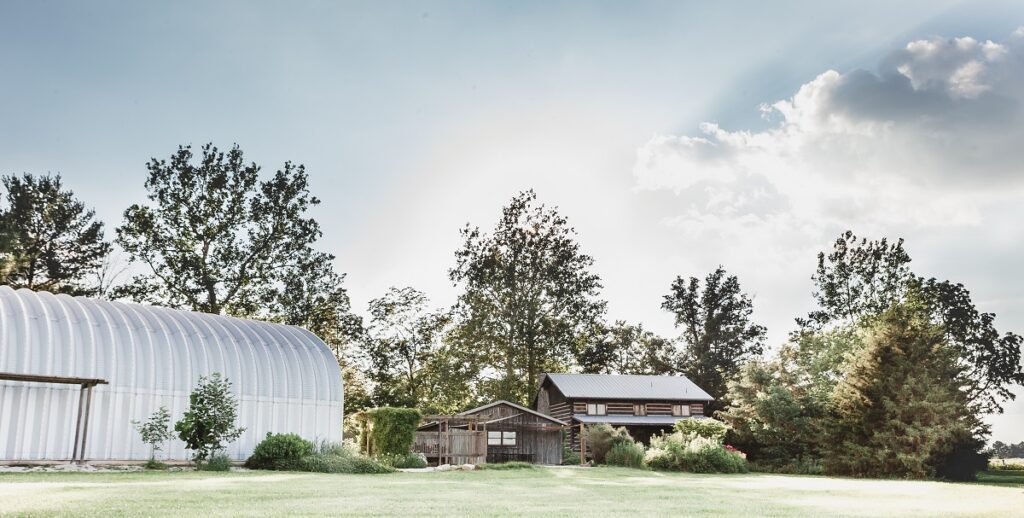
Vineyards are a relatively new and growing part of Indiana’s culture. You are invited to come experience life among the vines. Grab a Vineyard Tour map and take a self-guided stroll between the rows of four varieties of grapes. For more detailed information, call ahead to schedule a guided tour and learn about the vineyard’s landscape, maintenance, challenges and lessons. Other walking opportunities include nature paths for wildflower viewing in the spring and leaf collecting in the fall. The Butterfly Garden is at its peak in August when you can sip wine on the patio surrounded by butterflies or take a stroll down the Butterfly Path. Please come dressed and shod appropriately.
Winemaking in Central Indiana
Growing grapes in the middle of corn and soybean country may sound a little crazy. Bone-chilling winters, late spring frosts, and wet summers are all unfavorable to grapevines – at least the kind that come from Europe. But there are many species of grapes that are native to this continent and therefore more tempered to our climates. Grown in their native form or crossed with the vinifera species, many grape varieties and hybrids exist today that are not only hardy but very suited to winemaking. Scientists are starting to think that cool and humid climates may even stimulate production of the grape’s micronutrients most beneficial to humans.
Of course grapes aren’t the only thing from which you can make wine! We often hear stories of how past generations made wine from whatever their farm was blessed with each season — be it cherries, apples or persimmons. These country wines were celebrations of abundance and a “good batch” was remembered for years to come.
So France can do their thing and California too. Even Southern Indiana has hills and water features that allow them to come closer to the international wine model. We wish them all the best. But here in Central Indiana we’re focusing on what was created for this area and exploring the unique opportunities we have here. We believe there are many fun and exciting results awaiting our harvests of grapes and local fruits. When you visit Country Moon Winery we hope you are reminded of the unpretentious but precious wine made by early American settlers for their own enjoyment. Come help us celebrate the abundance!

The Vineyard
From the back patio of the winery you will see the grapevine rows opening toward the southwest, allowing predominant winds to provide important air circulation. Each of the following varieties have been chosen for their suitability to Central Indiana. They represent not only a wide assortment of varietal character but also a broad spectrum of heritage at the species level. As a group they have similar needs in maintenance and can grow in close proximity to one another, creating an attractive and efficient vineyard.
La Crescent – This golden grape is a charmer with its pronounced citrus flavor and snappy acidity. La Crescent vines make up our largest block of vines with plantings in 2005 and 2006. It is a very recently developed hybrid (1988) from the University of Minnesota and features a heritage of native riparia and German Muscat.
Concord – Pictured above left, Concords are a deep mystical blue color when ripe, softened by a dusty coat of naturally occurring yeasts. This native from the labrusca species was nurtured in the 1840s by Ephraim Wales Bull. From thousands of seed plantings, he fine-tuned the taste of what we now know as Concord. This taste has become the base of what Americans recognize as “grape” flavor. Concord is named after the town in Massachusetts where Bull’s original home and vineyard stands today. Our initial planting in 2004 was Concord and these vigorous vines promise many years of service.
Prairie Star – Slow starting but hard working is the projection for this new variety. With its heavy body and neutral flavor, Prairie Star will be an excellent addition to any fruit wine formula. In some years, it can develop a floral character that begs to stand on its own varietal virtues. Planted in 2008, this block of vines utilizes vertical shoot positioning for managing its upright growing habit.
Norton – From the aestivalis species this native is known either as Cynthiana or Norton, perhaps depending on whether you prefer its feminine or masculine qualities. Historically attributed to Dr. Daniel Norton of Richmond Virginia, this cultivar has been commercially available since 1830 but cited in journals as early as 1770. Very naturally resistant to disease, this vine’s boldness is reflected in the grape’s rich flavors and deep ruby color. The next road east of the winery happens to be named Cyntheanne so we hope our 2008 plantings sense some kinship in their new home.
The Vineyard Journal
Experience the vineyard online by following our blog page, “The Vineyard Journal.” Here you find random ponderings of the vinekeepers along with recipes, new release announcements and upcoming events.

